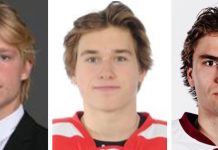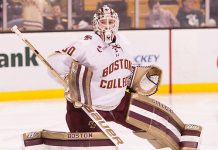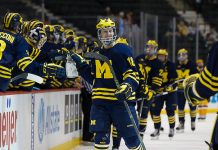If you think I’ve been spending too much time on unlikely Hobey Baker Award winners in this season’s Hobey Watch, then this post is for you because it’s all about Johnny Gaudreau.
Of course, it’s not lost on me that this post comes at a time when Gaudreau has been absent from the score sheet and Boston College is in an extremely tight race for the Hockey East regular season title. However, Gaudreau has been the dominant figure in the Hobey conversation since the season began, owing to his 12 points in eight postseason games last year, not to mention his 12-game point streak to start the season this year. A catchy nickname like “Johnny Hockey” doesn’t hurt, either.
For a number of weeks now, I’ve been sitting on the thought that if Gaudreau doesn’t win the Hobey Baker Award, it will confirm the bias I’ve suspected for some time against Boston College forwards when it comes to the Hobey Baker voting. As you probably know, the only Boston College player to win the Hobey under Jerry York is Mike Mottau, a defenseman, despite a steady stream of forwards who have posted gaudy numbers and earned Hobey finalist honors (including Hobey Hat Trick berths for Chris Collins, Nathan Gerbe and Cam Atkinson).
I’ve been wondering for some time if the numbers of BC forwards get discounted because they play in a system that produces so many high scorers (often with a similar small body frame), but the reality is that for every BC forward who didn’t win the Hobey, it had more to do with who else was in the picture that year (see below for details; I had originally planned to put the year-by-year breakdown in the middle, but that would make for a very long read.)
This year, despite some excellent seasons being posted by the likes of Nebraska-Omaha’s Ryan Walters, St. Lawrence’s Greg Carey and North Dakota’s Corban Knight and Danny Kristo, there really hasn’t been anyone else whom I could see winning the Hobey over Gaudreau. This year’s crop of Hobey candidates just doesn’t have a Ryan Miller or a Matt Carle who posted unheard-of numbers at his position, or a Peter Sejna or Jason Krog on track for 80 points. Until recently, my thinking was that this would finally be the year for the small BC forward, or that there would never be a year for the small BC forward.
Now, I’m not so sure. Gaudreau entered the weekend without a point in three of his last four games and six of his last nine. He was fifth in the nation in points per game, and while he has enjoyed more team success than players like Carey and Walters, Kristo and Knight pose an interesting challenge, particularly with North Dakota making a run in the WCHA and the PairWise Rankings. The fact that BC is in a dogfight — or is that a cat/bird/human fight? — with Massachusetts-Lowell, New Hampshire and Providence atop the Hockey East standings adds another wrinkle.
Here’s how I see it right now: If Gaudreau starts scoring more regularly and BC claims a Hockey East trophy (regular season or tournament), he should be able to win the Hobey. If not, the door is open for Kristo or Knight, or perhaps a dark-horse candidate like Quinnipiac goalie Eric Hartzell, who is almost assuredly a finalist (and possibly a Hat Trick member) for his role in putting the Bobcats atop ECAC Hockey and the PairWise.
How will it all shake out? We’ll see.
As promised earlier, here’s a look at former Boston College forwards and their Hobey candidacies:
Brian Gionta, 1999
The numbers: 39 GP, 27 goals, 33 assists, 60 points (8th in Division I)
Who won: Jason Krog, senior forward, New Hampshire, 41 GP, 34 goals, 51 assists, 85 points
This one’s something of an open-and-shut case. Say what you will about the different directions that Gionta’s and Krog’s careers took when they hit the pros, but the Hobey really isn’t about that. Between Krog being a senior, his team going to the Frozen Four that year, and, oh yeah, 85 points, I think it’s pretty clear why this one went the way it did.
Brian Gionta and Jeff Farkas, 2000
The numbers: 42 GP, 33 goals, 23 assists, 56 points (Gionta, 9th in Division I); 41 GP, 32 goals, 26 assists, 58 points (Farkas, 7th)
Who won: Mike Mottau, senior defenseman, Boston College, 42 GP, 6 goals, 37 assists
It’s worth pointing out here that neither Gionta nor Farkas was the national scoring leader in 1999-2000. That would be Steve Reinprecht from Wisconsin, who was the runner-up to Mottau. This is also one of those cases where having two players whose contributions are largely indistinguishable from one another really hurts. Mottau, on the other hand, was the top-scoring defenseman playing in a major conference that year and he was a senior, so that undoubtedly helped steer the votes to him.
Brian Gionta, 2001
The numbers: 43 GP, 33 goals, 21 assists, 54 points (14th in Division I)
Who won: Ryan Miller, sophomore goaltender, Michigan State, 40 GP, 31-5-4, 1.32 GAA, .950 save percentage
This is probably the best example of it all depending on who else is out there. Ryan Miller put together the season that is — fairly or not — the standard against which all goaltenders since have been judged. In 2007, when I was still with CSTV, I caught a fair bit of flak for arguing that David Brown wouldn’t win the Hobey because his numbers weren’t on the level of Miller’s. In retrospect, Brown may have been the most deserving candidate that year, and I would argue that his failure to capture the Hobey may be the best evidence of Miller’s standard being applied to the goaltenders who have been considered for the Hobey since. In any event, Miller’s NCAA-record .950 save percentage made him a fairly obvious winner.
Ben Eaves, 2003
The numbers: 36 GP, 18 goals, 39 assists, 57 points (10th in Division I)
Who won: Peter Sejna, junior forward, Colorado College, 42 GP, 36 goals, 46 assists, 82 points
Eaves is included in this list because he was a finalist, but there’s really nothing to see here. On the subject of no Hobey candidate existing in a vacuum, I’d call your attention to one David LeNeveu, whose goals against average of 1.20 was actually lower than Miller posted two years prior en route to the Hobey, and who also had a .940 save percentage to boot. Maybe, if there hadn’t been a Peter Sejna with an 82-point season that year, we wouldn’t be talking about all goalies being held to the Ryan Miller standard when it comes to the Hobey.
Tony Voce, 2004
The numbers: 42 GP, 29 goals, 18 assists, 47 points (12th in Division I)
Who won: Junior Lessard, senior forward, Minnesota-Duluth, 45 GP, 32 goals, 31 assists
Open and shut. Voce was never really in the picture, although Lessard was the only player with more goals that year. Still, Lessard was just about equally prolific passing the puck, so there’s not much of a question here.
Patrick Eaves, 2005
The numbers: 36 GP, 19 goals, 29 assists, 48 points (11th in Division I)
Who won: Marty Sertich, junior forward, Colorado College, 43 GP, 27 goals, 37 assists, 64 points
This one only seems funny in retrospect because of the different pro futures the two players found, but there really wasn’t much to this one.
Chris Collins, 2006
The numbers: 42 GP, 34 goals, 29 assists, 63 points (T-1st in Division I; includes hat trick in NCAA semifinal vs. North Dakota)
Who won: Matt Carle, junior defenseman, Denver, 39 GP, 11 goals, 42 assists
I remember this one well. The CSTV Hobey Watch panel incorrectly predicted a Hobey Hat Trick of Carle, Brian Elliott and Ryan Potulny (who tied with Collins for the nation’s highest point total, with a points-per-game edge of 0.04), as I was one of the only people to put Collins on my final ballot. In analyzing where the panel went wrong, I pointed out that since there’s been a Hobey Hat Trick, at least one of the eastern conferences has always been represented among the top three players, but looking back at this season, there’s little doubt that Collins earned his spot on far more than “East Coast Bias.” That having been said, he was definitely “the other guy” in this trio. In Carle, you had a defenseman with two NCAA championship rings and otherworldly numbers, while Elliott was the most important player on a Wisconsin team that won that season’s NCAA title. Could he have won in another year? Maybe, but this year probably had one of the best competitions for the Hobey in recent memory.
Nathan Gerbe, 2008
The numbers: 43 GP, 35 goals, 33 assists, 68 points (1st in Division I; includes five goals and three assists at Frozen Four)
Who won: Kevin Porter, senior forward, Michigan, 43 GP, 33 goals, 30 assists, 63 points (includes one assist at Frozen Four)
This is always a fun one to get into, particularly where the character considerations come into play. Gerbe, you’ll recall, had been suspended for one game early in the season for a spearing incident against Merrimack, which was accompanied by a comment from Hockey East commissioner Joe Bertagna about how this hadn’t been the first complaint he’d had about “inappropriate behavior” from Gerbe. As Gerbe started to really tear it up — he had 10 goals and nine assists in the last five games of 2007 — there were questions of how the suspension and comment would affect his Hobey candidacy (and a great hue and cry from certain corners of the college hockey landscape that Gerbe would even be considered for the award). As the season went on, Bertagna made comments that seemed to render the suspension a dead issue, but there was also the matter of Kevin Porter.
It should be noted that at the time of the final Hobey voting, Porter was the nation’s leading scorer (Gerbe wound up on top after he exploded for eight points in Denver), and he was one of two seniors on a Michigan team that won the CCHA regular season and tournament titles before entering the NCAA tournament as the top overall seed and advancing to the Frozen Four. The combination of scoring supremacy (at the time), leadership and seniority was enough to put Porter over the top, with or without any “character” concerns about Gerbe.
Cam Atkinson, 2011
The numbers: 39 GP, 31 goals, 21 assists, 52 points (10th in Division I)
Who won: Andy Miele, senior forward, Miami, 39 GP, 24 goals, 47 assists, 71 points
Atkinson made it to the Hobey Hat Trick, but like Collins before him he was the “other guy” in a trio that included Miele and North Dakota’s Matt Frattin. In the end, Miele averaged 1.82 PPG, posting more points than anyone since Sejna.


